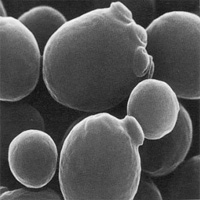
Saccharomyces
cerevisiae was introduced as an experimental
eukaryotic system for molecular biology mainly in the last two decades.
Although of greater genetic complexity compared to bacteria, yeast
is tractable by classical genetic techniques, a fact that enabled
rapid progress in the molecular genetics of the organism. S. cerevisiae
has then reached the forefront of experimental molecular biology since
it was the first eukaryotic organism whose entire genome sequence
has been made available.
Since then, yeast has proved
to be a useful model to compare sequences of metazoan and made possible
to identify mammalian ortologs in yeast cells. Thus: (a) YCF1, a gene
which confers cadmium resistance shares a great sequence similarity
with the human MRP1 and CFTR1 two members of the ATP transporter superfamily,
in which mutations origin the cystic fibrosis disease (b) the understanding
of amylodogenic disorders through the study of yeast prion biology
has known considerable advances (c) PAT1 and PAT2, encoding the sub-units
of the peroxisomal ATP-binding cassette required for the import of
long-chain fatty acids into the peroxisome, are the yeast homologs
of the human ALD gene.
Mutations in this gene are associated
to X-linked adrenoleucodystrophy (ALD), a neurometabolic disease with
a decreased ability to degrade very long chain fatty acids (VLCFA)
and significant phenotypic variation. The highly conserved cellular
functions from yeast to mammals associated with the ease of genetic
manipulation opened the possibility to functionally dissect gene products
from other eukaryotes and, in the “post-genomic era”,
yeast was again at the forefront in functional genomics.

